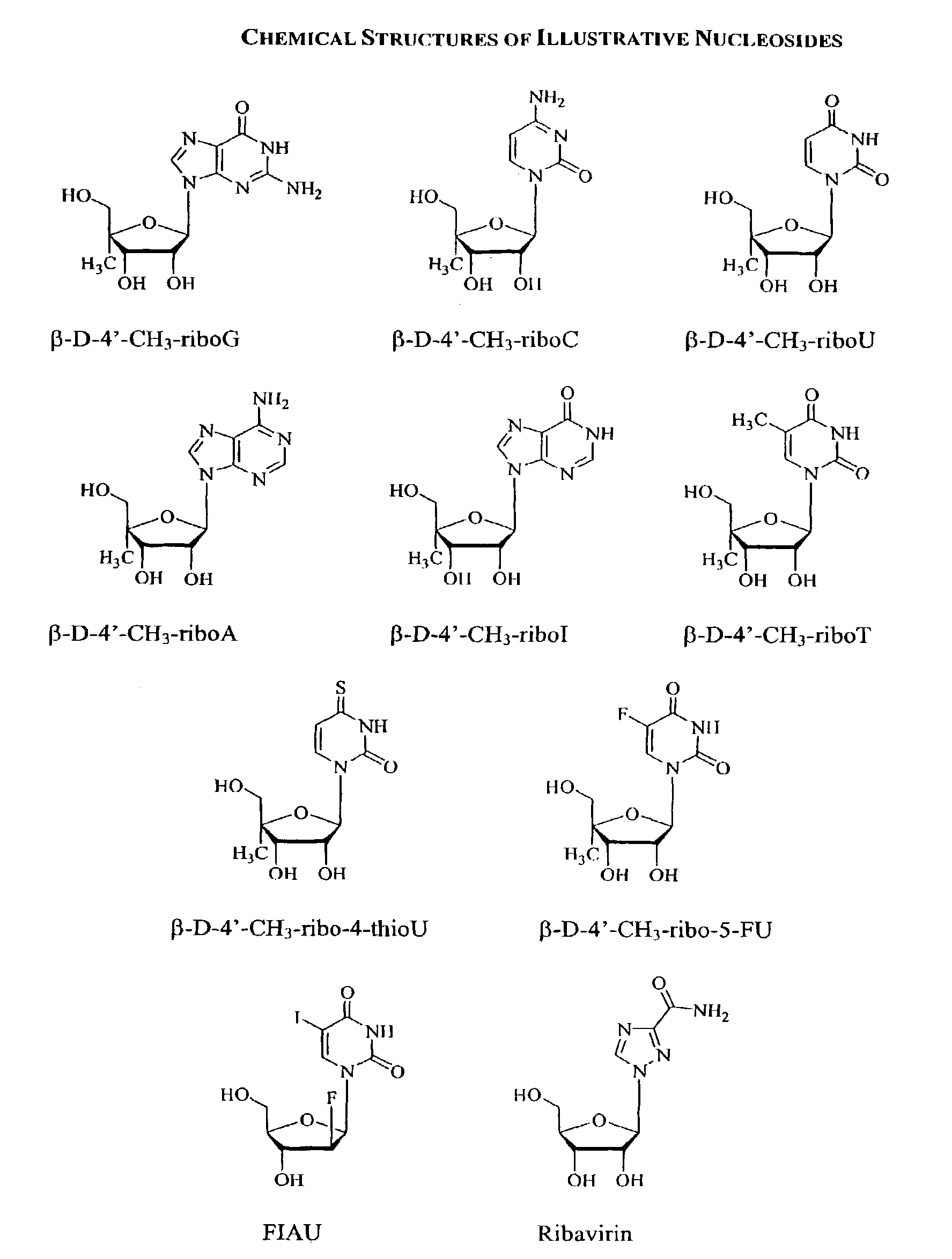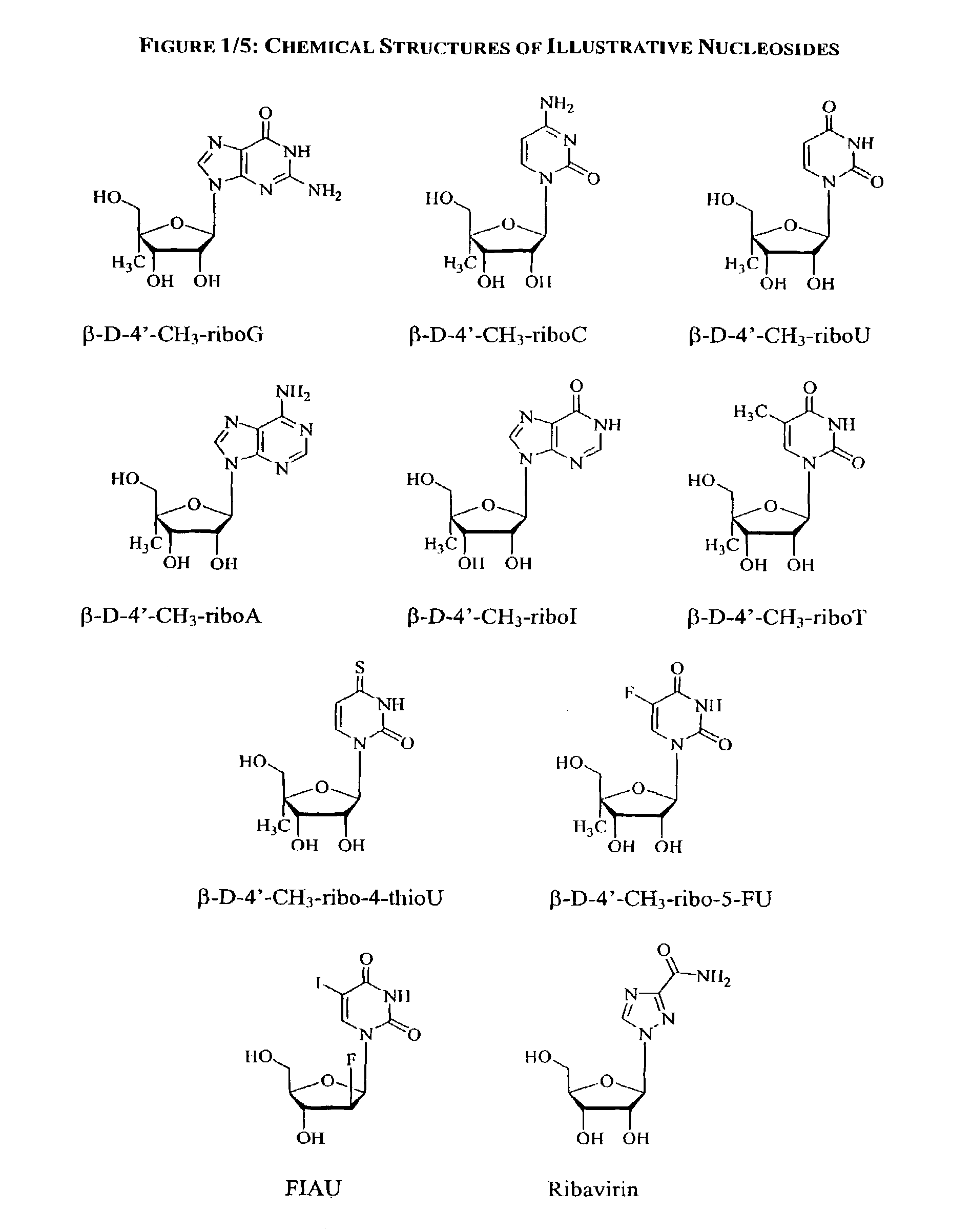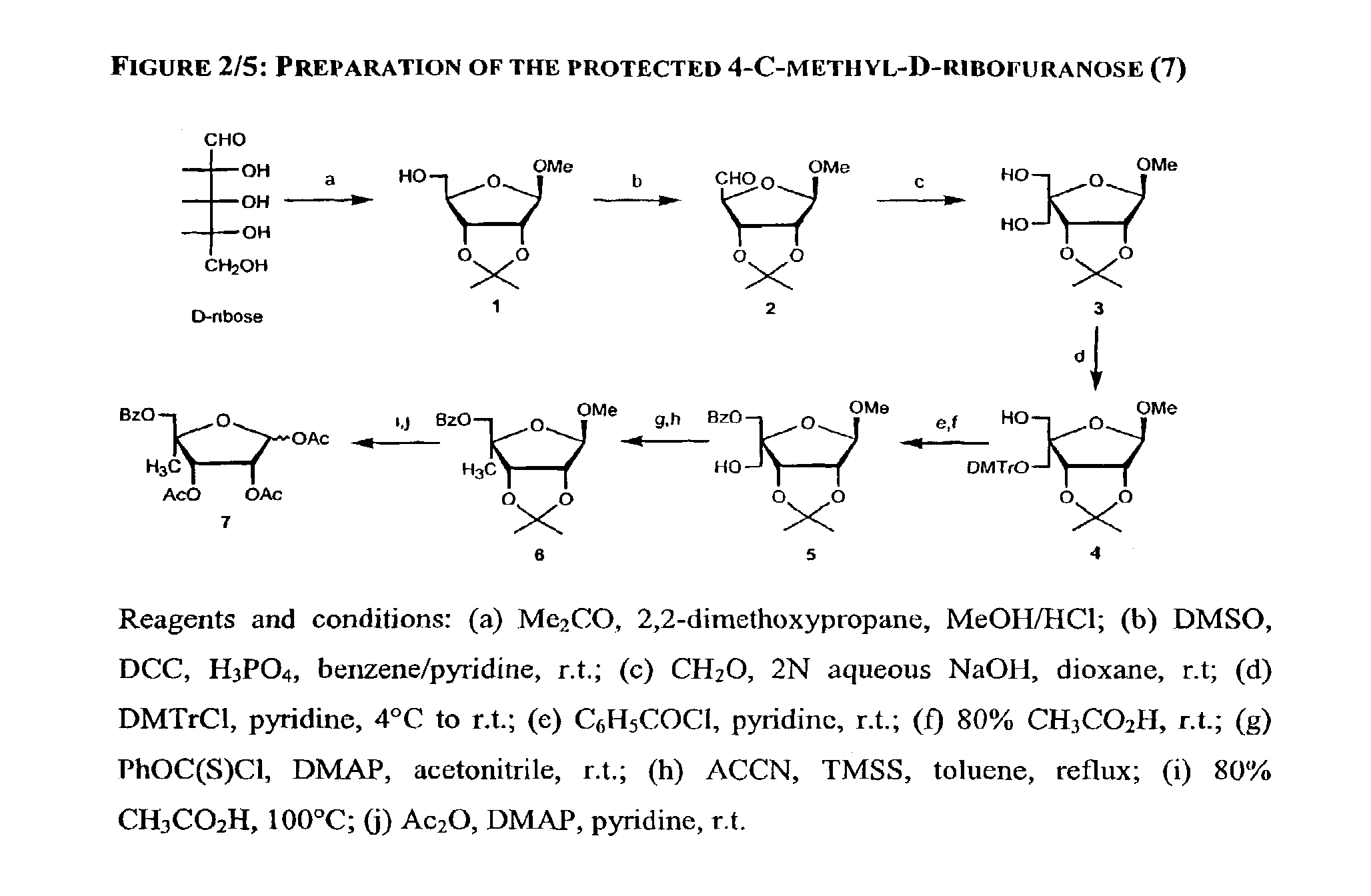Methods and compositions for treating hepatitis C virus using 4'-modified nucleosides
a technology of hepatitis c virus and nucleosides, applied in the field of pharmaceutical chemistry, can solve the problems of significant toxicity of ribavirin, ineffective ribavirin alone in reducing viral rna levels, and known to induce anemia, so as to inhibit hcv polymerase activity and determine the spectrum of activity
- Summary
- Abstract
- Description
- Claims
- Application Information
AI Technical Summary
Benefits of technology
Problems solved by technology
Method used
Image
Examples
example 1
Preparation of 1-O-Methyl-2,3-O-isopropylidene-β-D-ribofuranose (1)
[0255]The title compound can be prepared according to a published procedure (Leonard, N. J.; Carraway, K. L. “5-Amino-5-deoxyribose derivatives. Synthesis and use in the preparation of “reversed” nucleosides”J. Heterocycl. Chem. 1966, 3, 485–489).
[0256]A solution of 50.0 g (0.34 mole) of dry D-ribose in 1.0 L of acetone, 100 mL of 2,2-dimethoxypropane, 200 mL of methanol containing 20 mL of methanol saturated with hydrogen chloride at 0° C. was stirred overnight at room temperature. The resulting solution was neutralized with pyridine and evaporated under reduced pressure. The resulting oil was partitioned between 400 mL of water and 400 mL of methylene chloride. The water layer was extracted twice with methylene chloride (400 mL). The combined organic extracts were dried over sodium sulfate and evaporated under reduced pressure. The residue was purified by silica gel column chromatography [cluent: stepwise gradient ...
example 2
Preparation of 1-O-Methyl-2,3-O-isopropylidene-β-D-pentodialdo-ribofuranose (2)
[0257]The title compound can be prepared according to a published procedure (Jones, G. H.; Moffatt, J. G. Oxidation of carbohydrates by the sulfoxide-carbodiimide and related methods. Oxidation with dicyclohexylcarbodiimide-DMSO, diisopropylcarbodiimide-DMSO, acetic anhydride-DMSO, and phosphorus pentoxide-DMSO: in Methods in Carbohydrate Chemistry; Whisler, R. L. and Moffatt, J. L. Eds; Academic Press: New York, 1972; 315–322).
[0258]Compound 1 was co-evaporated twice with anhydrous pyridine. Dicyclohexylcarbodi-imide (DCC, 137.8 g, 0.67 mol) was added to a solution of 1 (68.2 g, 0.33 mole) in anhydrous benzene (670 mL), DMSO (500 mL) and pyridine (13.4 mL). To the resulting solution, cooled to 0° C., was added a solution of anhydrous crystalline orthophosphoric acid (16.4 g, 0.167 mmol) in anhydrous DMSO (30 mL). The mixture was stirred for 1.5 hours at 0° C. and 18 hours at room temperature under argon ...
example 3
Preparation of 4-C-Hydroxymethyl-1-O-methyl-2,3-O-isopropylidene-β-D-ribofuranose (3)
[0259]The title compound can be prepared according to a published procedure (Leland, D. L.; Kotick, M. P. “Studies on 4-C-(hydroxymethyl)pentofuranoses. Synthesis of 9-[4-C-(hydroxymethyl)-a-L-threo-pentofuranosyl]adenine”Carbohydr. Res. 1974, 38, C9-C11; Jones, G. H.; Taniguchi, M.; Tegg, D.; Moffatt, J. G. “4′-substituted nucleosides. 5. Hydroxylation of nucleoside 5′-aldehydes”J. Org. Chem. 1979, 44, 1309–1317; Gunic, E.; Girardet, J.-L.; Pietrzkowski, Z.; Esler, C.; Wang, G. “Synthesis and cytotoxicity of 4′-C- and 5′-C-substituted Toyocamycins”Bioorg. Med. Chem. 2001, 9, 163–170).
[0260]To a solution of the crude material (2) obtained above and 37% aqueous formaldehyde (167 mL) in dioxane (830 mL) was added aqueous sodium hydroxyde (2N, 300 mL). The mixture was stirred at room temperature for 4 hours and neutralized by addition of Dowex 50 W×2 (H+ form). The resin was filtered, washed with metha...
PUM
| Property | Measurement | Unit |
|---|---|---|
| Mass | aaaaa | aaaaa |
| Fraction | aaaaa | aaaaa |
| Fraction | aaaaa | aaaaa |
Abstract
Description
Claims
Application Information
 Login to View More
Login to View More - R&D
- Intellectual Property
- Life Sciences
- Materials
- Tech Scout
- Unparalleled Data Quality
- Higher Quality Content
- 60% Fewer Hallucinations
Browse by: Latest US Patents, China's latest patents, Technical Efficacy Thesaurus, Application Domain, Technology Topic, Popular Technical Reports.
© 2025 PatSnap. All rights reserved.Legal|Privacy policy|Modern Slavery Act Transparency Statement|Sitemap|About US| Contact US: help@patsnap.com



